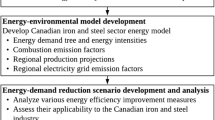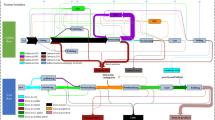Abstract
In the steel industry, the iron making system deals with large quantities of materials and energy and so it can play a critical role in reducing emissions and production costs. More specifically, excess by-product gases should be used for electricity generation; otherwise, they lead to pollution. A life cycle analysis is performed to compare the environmental impact of an iron making system with a combined cycle power plant (CCPP), to a system producing the same amount of electricity in a coal power plant. The results for a Chinese steel plant show a 33% reduction in the energy conservation and emission reduction potential for the CCPP system, which is thus more environmentally friendly. A mathematical programming formulation is then proposed for optimal scheduling. It incorporates key technological constraints and is sensitive to hourly changing electricity prices. The outcome is a 19% increase in revenue from electricity sales compared to a schedule that does not dynamically adjust to the price profile. The results also show that emissions from by-product gases can be avoided completely. The paper ends with a sensitivity analysis to evaluate the impact of changes in product demand, gas storage and CCPP capacity, and emission cost.










Similar content being viewed by others
References
Branco DAC, Moura MCP, Szklo A et al (2013) Emissions reduction potential from CO2 capture: a life-cycle assessment of a Brazilian coal-fired power plant. Energy Policy 61:1221–1235
Burchart-Korol D (2013) Life cycle assessment of steel production in Poland: a case study. J Clean Prod 54:235–243
Carvalho Pinto PC, da Silva TR, Linhares FM, de Andrade FV, de Oliveira Carvalho M M, Lima GM (2016) A integrated route for CO2 capture in the steel industry and its conversion into CaCO3 using fundamentals of Solvay process. Clean Technol Environ Policy 18(4):1123–1139
Castro PM, Grossmann IE (2014) Global optimal scheduling of crude oil blending operations with RTN continuous-time and multiparametric disaggregation. Ind Eng Chem Res 53:15127–15145
Castro P, Matos H, Barbosa-Póvoa APFD (2002) Dynamic modelling and scheduling of an industrial batch system. Comput Chem Eng 26:671–686
Castro PM, Harjunkoski I, Grossmann IE (2009a) New continuous-time scheduling formulation for continuous plants under variable electricity Cost. Ind Eng Chem Res 48:6701–6714
Castro PM, Westerlund J, Forssell S (2009b) Scheduling of a continuous plant with recycling of byproducts: a case study from a tissue paper mill. Comput Chem Eng 33:347–358
Castro PM, Harjunkoski I, Grossmann IE (2011) Optimal scheduling of continuous plants with energy constraints. Comput Chem Eng 35:372–387
Castro PM, Sun L, Harjunkoski I (2013) Resource–task network formulations for industrial demand side management of a steel plant. Ind Eng Chem Res 52:13046–13058
Chen W, Yin X, Ma D (2014) A bottom-up analysis of China’s iron and steel industrial energy consumption and CO2 emissions. Appl Energy 136:1174–1183
Clarke Energy (2016) Steel production gas for power production. Clarke Energy. www.clarkeenergy.com/steel-production-gas/. Accessed 10 Oct 2016
Dipu AL, Ryu J, Kato Y (2012) Carbon dioxide electrolysis for a carbon-recycling iron-making system. ISIJ Int 52:1427–1432
Ebalance Version 4.7 LCA software and Database. Integrated knowledge of our environment (IKE), China. www.ike-global.com. Accessed 10 Oct 2016
Guinée JB (ed) (2002) Handbook on life cycle assessment. Operational guide to the ISO standards. Kluwer Academic Publishers, Dordrecht
Hadera H, Harjunkoski I, Sand G, Grossmann IE (2015) Optimization of steel production scheduling with complex time-sensitive electricity cost. Comput Chem Eng 76:117–136
Harjunkoski I, Maravelias C, Bongers P, Castro PM, Engell S, Grossmann IE, Hooker J, Méndez C, Sand G, Wassick J (2014) Scope for industrial applications of production scheduling models and solution methods. Comput Chem Eng 62:161–193
IPCC (2007) Climate change fourth assessment report: climate change 2007. www.ipcc.ch/ipccreports/assessments-reports.htm. Accessed 10 Oct 2016
ISO 14040 (2006) Environmental management—life cycle assessment—principles and framework. International Organization of Standardization, Geneva
Kong H, Qi E, Li H, Li G, Zhang X (2010) An MILP model for optimization of by-product gases in the integrated iron and steel plant. Appl Energy 87:2156–2163
Ma D, Hasanbeigi A, Price L, Chen W (2015) Assessment of energy-saving and emission reduction potentials in China’s ammonia industry. Clean Technol Environ Policy 17(6):1633–1644
Nolde K, Morari M (2010) Electrical load tracking scheduling of a steel plant. Comput Chem Eng 34:1899–1903
Oliveira Junior VB, Pena JGC, Salles JLF (2016) An improved plant-wide multiperiod optimization model of a by-product gas supply system in the iron and steel-making process. Appl Energy 164:462–474
Olmez GM, Dilek FB, Karanfil T et al (2016) The environmental impacts of iron and steel industry: a life cycle assessment study. J Clean Prod 130:195–201
Pantelides CC (1994) Unified frameworks for optimal process planning and scheduling. In: Proceedings on the second conference on foundations of computer aided operations. Cache Publications, New York, pp 253–274
Porzio GF, Fornai B, Amato A et al (2013) Reducing the energy consumption and CO2 emissions of energy intensive industries through decision support systems—an example of application to the steel industry. Appl Energy 112:818–833
Qi Y, Wang Q, Yan D, Guo P (2015) Method for iron-making with full oxygen and hydrogen-rich gas and equipment thereof: U.S. Patent Application 14/622, p 105
Song G, Qiu T, Chen B (2015) Improved resource-task network-based flare minimization model for ethylene plant start-up: rigorous treatment of cracking furnace and high-pressure steam. Ind Eng Chem Res 54:6326–6333
State Grid (2016) The newest electricity prices in Beijing. State Grid, China. www.95598.cn/static/html//person/sas/es//PM06003001_2016037918467080.shtml. Accessed 10 Oct 2016 (in Chinese)
Wassick JM, Ferrio J (2011) Extending the resource task network for industrial applications. Comput Chem Eng 35(10):2124–2140
Wei-Hua Y, Tao X, Wei L, Guang C, Li-Yue J, Yue-Jiao G (2009) Waste gases utilization and power generation in iron and steel works. In intelligent information technology application workshops, 2009. IITAW’09. Third international symposium on IEEE, pp 246–249
Yuan J, Kang J, Yu C et al (2011) Energy conservation and emissions reduction in China—progress and prospective. Renew Sustain Energy Rev 15(9):4334–4347
Zeng S, Lan Y, Huang J (2009) Mitigation paths for Chinese iron and steel industry to tackle global climate change. Int J Greenh Gas Control 3(6):675–682
Zhang H, Dong L, Li H et al (2013) Analysis of low-carbon industrial symbiosis technology for carbon mitigation in a Chinese iron/steel industrial park: a case study with carbon flow analysis. Energy Policy 61:1400–1411
Acknowledgements
Lv Zhimin and Li Ting acknowledge financial support from the National Natural Science Foundation of China (Grant No. 51274043). Pedro Castro acknowledges financial support from Fundação para a Ciência e Tecnologia through the Investigador FCT Program and Project UID/MAT/04561/2013.
Author information
Authors and Affiliations
Corresponding author
Rights and permissions
About this article
Cite this article
Li, T., Castro, P.M. & Lv, Z. Life cycle assessment and optimization of an iron making system with a combined cycle power plant: a case study from China. Clean Techn Environ Policy 19, 1133–1145 (2017). https://doi.org/10.1007/s10098-016-1306-9
Received:
Accepted:
Published:
Issue Date:
DOI: https://doi.org/10.1007/s10098-016-1306-9




